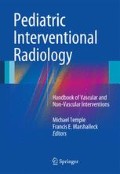Abstract
The development of magnetic resonance cholangiography has led to a decrease in the utilization of and indications for percutaneous biliary cholangiography in diagnosis of pediatric biliary diseases. However, interventional radiologists still play a central role in treatment of diseases such as biliary obstruction, choledocolithiasis, and cholecystitis.
Access this chapter
Tax calculation will be finalised at checkout
Purchases are for personal use only
References
Valette PJ, De Baere T. Anatomie biliaire et vasculaire du foie. J Radiol. 2002;83(2 Pt 2):221–32.
Hoevels J. Percutaneous transhepatic cholangiography and percutaneous biliary drainage. In: Dondelinger RF, Rossi P, Kurdziel JC, Wallace S, editors. Interventional radiology. New York, NY: Thieme Medical; 1990. p. 187–99.
Davenport M. Biliary atresia. Semin Pediatr Surg. 2005;14:42–88.
Fischler B, Ehrnst A, Forsgren M, Orvell C, Nemeth A. The viral association of neonatal cholestasis in Sweden: a possible link between cytomegalovirus infection and extrahepatic biliary atresia. J Pediatr Gastroenterol Nutr. 1998;27:57–64.
Hart MH, Kaufman SS, Vanderhoof JA, et al. Neonatal hepatitis and extrahepatic biliary atresia associated with cytomegalovirus infection in twins. Am J Dis Child. 1991;145:302–5.
Lachaux A, Descos B, Plauchu H, et al. Familial extrahepatic biliary atresia. J Pediatr Gastroenterol Nutr. 1988;7:280–3.
Kasai M, Suzuki H, Ohashi E, Ohi R, Chiba T, Okamoto A. Technique and results of operative management of biliary atresia. World J Surg. 1978; 2:571–9.
Pariente D, Franchi-Abella S. Cystic biliary atresia is different from choledochal cyst. Pediatr Radiol. 2009; 39:1019.
Wiseman K, Buczkowski AK, Chung SW, Francoeur J, Schaeffer D, Scudamore CH. Epidemiology, presentation, diagnosis, and outcomes of choledochal cysts in adults in an urban environment. Am J Surg. 2005;189:527–31.
Kim OH, Chung HJ, Choi BG. Imaging of the choledochal cyst. Radiographics. 1995;15:69–88.
Gauthier F, Brunelle F, Valayer J. Common channel for bile and pancreatic ducts. Presentation of 12 cases and discussion. Chir Pediatr. 1986;27:148–52.
Babbitt DP, Starshak RJ, Clemett AR. Choledochal cyst: a concept of etiology. Am J Roentgenol Radium Ther Nucl Med. 1973;119:57–62.
Mortelé KJ, Rocha TC, Streeter JL, Taylor AJ. Multimodality imaging of pancreatic and biliary congenital anomalies. Radiographics. 2006;26:715–31.
Miller WJ, Sechtin AG, Campbell WL, Pieters PC. Imaging findings in Caroli’s disease. AJR Am J Roentgenol. 1995;165:333–7.
Brown RM. Pathology of neonatal liver biopsy. Curr Diagn Pathol. 2006;12:202–9.
Hadchouel M. Le syndrome d’Alagille. www.orpha.net . May 2002.
Hoffenberg EJ, Narkewicz MR, Sondheimer JM, Smith DJ, Silverman A, Sokol RJ. Outcome of syndromic paucity of interlobular bile ducts (Alagille syndrome) with onset of cholestasis in infancy. J Pediatr. 1995;127:220–4.
Alagille D, Estrada A, Hadchouel M, Gautier M, Odièvre M, Dommergues J. Syndromic paucity of interlobular bile ducts (Alagille syndrome or arteriohepatic dysplasia): review of 80 cases. J Pediatr. 1987;110:195–200.
Sisto A, Feldman P, Garel L, et al. Primary sclerosing cholangitis in children: study of five cases and review of the literature. Pediatrics. 1987;80:918–23.
Mieli-Vergani G, Vergani D. Sclerosing cholangitis in the paediatric patient. Best Pract Res Clin Gastroenterol. 2001;15:681–90.
Debray D, Pariente D, Urvoas E, Hadchouel M, Bernard O. Sclerosing cholangitis in children. J Pediatr. 1994;124:49–56.
Wilschanski M, Chait P, Wade JA, et al. Primary sclerosing cholangitis in 32 children: clinical, laboratory, and radiographic features, with survival analysis. Hepatology. 1995;22:1415–22.
Pall H, Bancroft JD, Jonas M. One third of children with primary sclerosing cholangitis have normal cholangiograms at diagnosis. Gastroenterology. 2003;124 Suppl 1:A784.
Sunku B, Salvalaggio PR, Donaldson JS, et al. Outcomes and risk factors for failure of radiologic treatment of biliary strictures in pediatric liver transplantation recipients. Liver Transpl. 2006;12:821–6.
Lorenz JM, Denison G, Funaki B, Leef JA, Van Ha T, Rosenblum JD. Balloon dilatation of biliary-enteric strictures in children. AJR Am J Roentgenol. 2005; 184:151–5.
Berrocal T, Parrón M, Alvarez-Luque A, Prieto C, Santamarıa ML. Pediatric liver transplantation: a pictorial essay of early and late complications. Radiographics. 2006;26:1187–209.
Saad WE, Davies MG, Saad NE, et al. Transhepatic dilatation of anastomotic biliary strictures in liver transplant recipients with use of a combined cutting and conventional balloon protocol: technical safety and efficacy. J Vasc Interv Radiol. 2006;17: 837–43.
Donnelly LF, Bisset 3rd GS, Frush DP. Diagnosis please. Case 2: embryonal rhabdomyosarcoma of the biliary tree. Radiology. 1998;208:621–3.
Spunt SL, Lobe TE, Pappo AS, et al. Aggressive surgery is unwarranted for biliary tract rhabdomyosarcoma. J Pediatr Surg. 2000;35:309–16.
Debray D, Pariente D, Gauthier F, Myara A, Bernard O. Cholelithiasis in infancy: a study of 40 cases. J Pediatr. 1993;122:385–91.
Tarnasky PR, Tagge EP, Hebra A, et al. Minimally invasive therapy for choledocholithiasis in children. Gastrointest Endosc. 1998;47:189–92.
Wicky S, Gudinchet F, Barghouth G, Schnyder P. Three-dimensional cholangio-spiral CT demonstration of a post-traumatic bile leak in a child. Eur Radiol. 1999;9:99–102.
Wong YC, Wang LG, Chen RJ, Chen CJ. Magnetic resonance imaging of extrahepatic bile duct disruption. Eur Radiol. 2002;12:2488–90.
Youngson GG, Driver CP, Mahomed AA, Duddalwar VA. Computed tomographic cholangiography in the diagnosis of bile duct injury in children. J Pediatr Surg. 2003;38:E18–20.
Singh V, Narasimhan KL, Verma GR, Singh G. Endoscopic management of traumatic hepatobiliary injuries. J Gastroenterol Hepatol. 2007;22: 1205–9.
Sharif K, Pimpalwar AP, John P, et al. Benefits of early diagnosis and preemptive treatment of biliary tract complications after major blunt liver trauma in children. J Pediatr Surg. 2002;37:1287–92.
Wales PW, Brindle M, Sauer CJE, et al. Percutaneous cholangiography for the treatment of parenteral nutrition-associated cholestasis in surgical neonates: preliminary experience. J Pediatr Surg. 2007;42(11): 1913–8.
Author information
Authors and Affiliations
Corresponding author
Editor information
Editors and Affiliations
Rights and permissions
Copyright information
© 2014 Springer Science+Business Media New York
About this chapter
Cite this chapter
Dubois, J., Garel, L. (2014). Biliary Intervention in Children. In: Temple, M., Marshalleck, F. (eds) Pediatric Interventional Radiology. Springer, New York, NY. https://doi.org/10.1007/978-1-4419-5856-3_21
Download citation
DOI: https://doi.org/10.1007/978-1-4419-5856-3_21
Published:
Publisher Name: Springer, New York, NY
Print ISBN: 978-1-4419-5855-6
Online ISBN: 978-1-4419-5856-3
eBook Packages: MedicineMedicine (R0)

